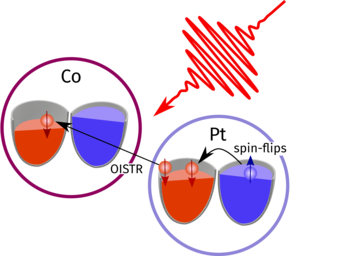Joint experiment and theory TRR227 paper in Nature Communications
Optical intersite spin transport (OISTR) can occur when suitable atoms of different types are adjacent in a solid. A light pulse may trigger a displacement of electrons from one atom to its neighbor. - © MBI
Combining experiment and theory, researchers from the Max Born Institute for Nonlinear Optics and Short Pulse Spectroscopy (MBI) and the Max Planck Institute of Microstructure Physics have disentangled how laser pulses can manipulate magnetization via ultrafast transfer of electrons between different atoms.
News from Feb 18, 2020
TRR 227 researchers (Clemens v. Korff Schmising, Stefan Eisebitt, and Sangeeta Sharma) from the Max Born Institute in Berlin and the Max Planck Institute for Microstructure Physics in Halle, combining experimental and theoretical work, have now witnessed a new microscopic process “at work”, which was predicted only recently. The process, called optical intersite spin transport (OISTR), can occur when suitable atoms of different types are adjacent in a solid. Under suitable conditions, a light pulse triggers a displacement of electrons from one atom to its neighbor. Importantly, this happens predominantly with electrons of a particular spin orientation and thus influences the local magnetization.
This process takes place during optical excitation and does not depend on secondary mechanisms. It is, therefore, the fastest process imaginable leading to a light-induced change in magnetism.
F. Willems, C. v. Korff Schmising, C. Strüber, D. Schick, D. W. Engel, J. K. Dewhurst, P. Elliott, S. Sharma, and S. Eisebitt: Optical inter-site spin transfer probed by energy and spin-resolved transient absorption spectroscopy - Nat. Commun. 11, 871 (2020) - DOI: 10.1038/s41467-020-14691-5

